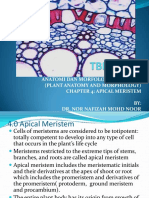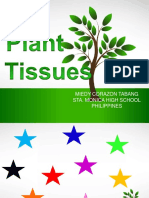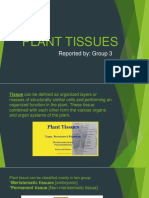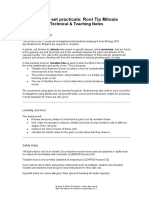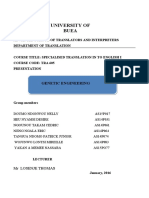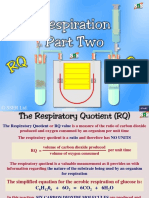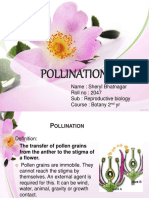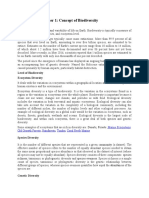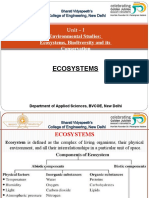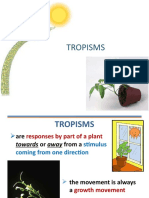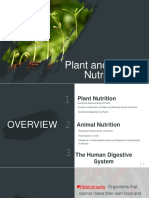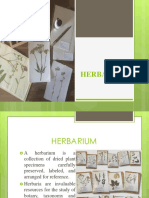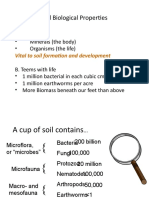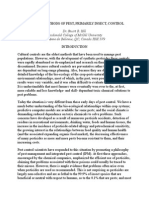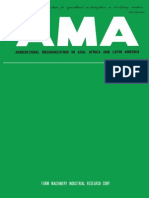Plant Structure and Function - Learner's Guide
Plant Structure and Function - Learner's Guide
Uploaded by
hasbiallah1306Copyright:
Available Formats
Plant Structure and Function - Learner's Guide
Plant Structure and Function - Learner's Guide
Uploaded by
hasbiallah1306Original Description:
Copyright
Available Formats
Share this document
Did you find this document useful?
Is this content inappropriate?
Copyright:
Available Formats
Plant Structure and Function - Learner's Guide
Plant Structure and Function - Learner's Guide
Uploaded by
hasbiallah1306Copyright:
Available Formats
NQF Level:
US No:
116057
Learner Guide
Primary Agriculture
Plant Structure
and Function
My name: . . . . . . . . . . . . . . . . . . . . . . . . . . . . . . . . . . . . . . . . . .
Company: . . . . . . . . . . . . . . . . . . . . . . . . . . . . . . . . . . . . . . . . . .
Commodity: . . . . . . . . . . . . . . . . . . . . Date: . . . . . . . . . . . . . . .
The availability of this product is due to the financial support of the National
Department of Agriculture and the AgriSETA. Terms and conditions apply.
Understand the structure and functions of a plant
Primary Agriculture
NQF Level 2
Unit Standard No: 116057
B ef o r e we st ar t
Dear Learner - This Learner Guide contains all the information to acquire all the
knowledge and skills leading to the unit standard:
Title:
US No:
Understand the structure and functions of a plant
116057
NQF Level: 2
Credits: 5
The full unit standard will be handed to you by your facilitator. Please read the unit
standard at your own time. Whilst reading the unit standard, make a note of your
questions and aspects that you do not understand, and discuss it with your
facilitator.
This unit standard is one of the building blocks in the qualifications listed below.
Please mark the qualification you are currently doing:
Title
ID Number
NQF Level
Credits
National Certificate in Animal Production
48976
120
National Certificate in Mixed Farming Systems
48977
120
National Certificate in Plant Production
48975
120
Are you enrolled in a:
Please mark the learning program you
are enrolled in:
Learnership?
Your facilitator should explain the above
concepts to you.
Short Course?
Mark
Skills Program?
This Learner Guide contains all the information, and more, as well as the activities
that you will be expected to do during the course of your study. Please keep the
activities that you have completed and include it in your Portfolio of Evidence.
Your PoE will be required during your final assessment.
Version: 01
Version Date: July 2006
Understand the structure and functions of a plant
Primary Agriculture
NQF Level 2
Unit Standard No: 116057
Wh at is assessmen t all ab o u t ?
You will be assessed during the course of your study. This is called formative
assessment. You will also be assessed on completion of this unit standard. This is
called summative assessment. Before your assessment, your assessor will discuss
the unit standard with you.
Assessment takes place at different intervals of the learning process and includes
various activities. Some activities will be done before the commencement of the
program whilst others will be done during programme delivery and other after
completion of the program.
The assessment experience should be user friendly, transparent and fair. Should
you feel that you have been treated unfairly, you have the right to appeal. Please
ask your facilitator about the appeals process and make your own notes.
H o w t o u se t h e ac t iv it y sh eet s
Your activities must be handed in from time to time on request of the facilitator for
the following purposes:
The activities that follow are designed to help you gain the skills, knowledge
and attitudes that you need in order to become competent in this learning
module.
It is important that you complete all the activities and worksheets, as directed
in the learner guide and at the time indicated by the facilitator.
It is important that you ask questions and participate as much as possible in
order to play an active roll in reaching competence.
When you have completed all the activities and worksheets, hand this
workbook in to the assessor who will mark it and guide you in areas where
additional learning might be required.
You should not move on to the next step in the assessment process until this
step is completed, marked and you have received feedback from the assessor.
Sources of information to complete these activities should be identified by your
facilitator.
Please note that all completed activities, tasks and other items on which you
were assessed must be kept in good order as it becomes part of your
Portfolio of Evidence for final assessment.
E n j oy t h i s l e a r n i n g e xp e r i e n c e !
Version: 01
Version Date: July 2006
Understand the structure and functions of a plant
Primary Agriculture
NQF Level 2
Unit Standard No: 116057
H o w t o u se t h is g u id e
Throughout this guide, you will come across certain re-occurring boxes. These
boxes each represent a certain aspect of the learning process, containing
information, which would help you with the identification and understanding of these
aspects. The following is a list of these boxes and what they represent:
What does it mean? Each learning field is characterized by unique terms and
definitions it is important to know and use these terms and definitions correctly. These
terms and definitions are highlighted throughout the guide in this manner.
You will be requested to complete activities, which could be group activities, or individual
activities. Please remember to complete the activities, as the facilitator will assess it and
these will become part of your portfolio of evidence. Activities, whether group or individual
activities, will be described in this box.
Examples of certain
concepts or principles to
help you contextualise
them easier, will be shown
in this box.
The following box indicates a summary of
concepts that we have covered, and offers
you an opportunity to ask questions to your
facilitator if you are still feeling unsure of
the concepts listed.
M y N ot e s
You can use this box to jot down questions you might have, words that you do not understand,
instructions given by the facilitator or explanations given by the facilitator or any other remarks that
will help you to understand the work better.
. . . . . . . . . . . . . . . . . . . . . . . . . . . . . . . . . . . . . . . . . . . . . . . . . . . . . . . . . . . . . . . . . . . . . . . . . . . . . .. . . . .
..................................................................................
..................................................................................
..................................................................................
..................................................................................
..................................................................................
Version: 01
Version Date: July 2006
Understand the structure and functions of a plant
Primary Agriculture
NQF Level 2
Unit Standard No: 116057
Wh at ar e we g o in g t o lear n ?
What will I be able to do? ..................................................................................
What do I need to know? .....................................................................................
Plant Structure An Introduction..
Session 1: Parts and Function of Seeds............................................................
Session 2: Root systems and root function....
13
Session 3: The different stem types..
17
Session 4: Different leaf types and their functions..........................................
20
Session 5
Parts of a Flower and their Functions..
27
Session 6
Types of fruit and parts of fruit....
32
Am I ready for my test? ...................................................................
36
Checklist for Practical assessment...................................................
38
Paperwork to be done.......................................................................
39
Bibliography..
40
Terms & Conditions..
40
Acknowledgements..
41
SAQA Unit Standard
Version: 01
Version Date: July 2006
Understand the structure and functions of a plant
Primary Agriculture
NQF Level 2
Unit Standard No: 116057
What will I be able to do?
When you have achieved this unit standard, you will be able to:
Explain the functions of different plant parts.
Learners will gain specific knowledge and skills in order to be able to
understand the roll that each part of the plant plays in the ecological
environment as well as in plant production.
They will be capacitated to gain access to the mainstream agricultural sector,
in plant production, impacting directly on the sustainability of the sub-sector.
The improvement in production technology will also have a direct impact on
the improvement of agricultural productivity of the sector.
What do I need to know?
It is expected of the learner attempting this unit standard to demonstrate
competence against the unit standard::
NQF 1: Understand the role of plants in the ecological environment.
NQF 1: Demonstrate a basic understanding of the structure and function of a
plant in relation to its environment.
NQF 1: Demonstrate an understanding of the basic concept of sustainable
farming systems.
Plant structure An Introduction
What is Plant Structure?
Plants are made up of organs like the roots, stems and leaves, and for sexual
reproduction, they form flowers and fruit containing the seed. We can see these
organs with the naked (unaided) eye and we therefore talk about the external
structure of the plant. All these organs are made up of cells that we cannot see
with the naked eye and need a microscope to see these cells. We therefore talk
about the internal structure or the anatomy of the plant. Cells of the same kind
and/or function form tissues like the epidermis, cortex and vascular tissue. Each
tissue has a specific function in the plant organ and when we are talking about the
function of the leaf, we must actually refer to the function of each kind of tissue
inside the leaf like the stomata in the epidermis responsible for transpiration and gas
exchange.
Please complete
Activity 1.1 at the
end of the section.
My Notes
.........................................
.........................................
.........................................
. . . . .. . . . . . . . . . . . . . . . . . . . . . . . . . . . . . . . . . . . .
Version: 01
Version Date: July 2006
Understand the structure and functions of a plant
Primary Agriculture
1.1
NQF Level 2
Explore and discuss
Unit Standard No: 116057
My Name:
..................
My Workplace:
..................
My ID Number:
AC 1
...................
Take a scale from an onion bulb and use a pair of tweezers to tare off a piece of the
epidermis tissue. Mount it in a drop of water and study it under a microscope. Write
down your observations and discuss it with the rest of the class.
..........................................................................................................................
..........................................................................................................................
..........................................................................................................................
..........................................................................................................................
..........................................................................................................................
..........................................................................................................................
..........................................................................................................................
..........................................................................................................................
..........................................................................................................................
..........................................................................................................................
..........................................................................................................................
..........................................................................................................................
..........................................................................................................................
..........................................................................................................................
..........................................................................................................................
..........................................................................................................................
..........................................................................................................................
..........................................................................................................................
Facilitator comments:
Assessment:
Version: 01
Version Date: July 2006
Understand the structure and functions of a plant
Primary Agriculture
Session
NQF Level 2
Unit Standard No: 116057
Parts and function of seeds
After completing this session, you should be able to:
SO 1: Identify the basic parts that make up a seed and
explain the function.
1.1
Identify the basic parts that make up a
seed and explain the function
The simplest way to describe a seed is a baby in a box with food where the box
represents the seed coat, the baby represents the embryo and the food
represents the endosperm.
Seed coat (box)
Cotyledon
Plumule
Embryo (baby)
Axis
Radicle
Endosperm (Food)
Please complete
Activity 1.2 at the
end of the section.
My Notes
.........................................
.........................................
.........................................
. . . . .. . . . . . . . . . . . . . . . . . . . . . . . . . . . . . . . . . . . .
My Notes
. . . . . . . . . . . . . . . . . . . . . . . . . . . . . . . . . . . . . . . . . . . . . . . . . . . . . . . . . . . . . . . . . . . . . . . . . . . . . .. . . .
..................................................................................
..................................................................................
..................................................................................
..................................................................................
Version: 01
Version Date: July 2006
Understand the structure and functions of a plant
Primary Agriculture
1.2
NQF Level 2
Explore
Unit Standard No: 116057
My Name:
..................
My Workplace:
..................
My ID Number:
SO 1 AC 1-5
...................
Soak some bean seed and some maize seed in water for 24 hours. Remove the seed
coat and try to find the other parts shown in the diagram.
..........................................................................................................................
..........................................................................................................................
..........................................................................................................................
..........................................................................................................................
..........................................................................................................................
..........................................................................................................................
..........................................................................................................................
..........................................................................................................................
..........................................................................................................................
..........................................................................................................................
..........................................................................................................................
..........................................................................................................................
..........................................................................................................................
..........................................................................................................................
..........................................................................................................................
..........................................................................................................................
..........................................................................................................................
..........................................................................................................................
Facilitator comments:
Assessment:
Version: 01
Version Date: July 2006
Understand the structure and functions of a plant
Primary Agriculture
NQF Level 2
Unit Standard No: 116057
10
1.2& Functions of the seed parts and their
1.3 relation with plant organs
Seed coat the seed coat derives from the integuments of the ovule and
covers and protects the seed while in a resting phase (storage).
Endosperm The endosperm derives from the fertilised central cell of the
embryo sac and contains the energy (food) for the embryo. In the immature
stage, therefore, all seeds contain endosperm. In some seeds the endosperm is
absorbed by the cotyledons of the developing embryo, so that the cotyledons
become swollen and no endosperm remains in the mature seed. Such seeds are
called ex-endospermous. In other seeds (endospermous seeds) the endosperm s
stored around the embryo inside the seed coat and is. The mature seed
therefore contains endosperm that is absorbed only during germination to supply
the germinating embryo with the required energy.
Embryo the embryo consists of four parts:
Radicle It is the root apical meristem of the embryo that gives rise to
the primary root.
Plumule It is the apical meristem (growing point) of the young embryo
that gives rise to the stem and leaves of the new plant.
Cotyledon(s) One in monocotyledonous seeds and two in
dicotyledonous seeds, is (are) the first leaf (leaves) of the embryo
produced by the plumule and do (es) contain axillary buds like any other
leaf. They act as haustoria (absorbing) nutrients from the endosperm. In
endospermous seeds (seeds containing endosperm), the cotyledons
become active during germination and absorb the nutrients from the
endosperm as they are required by the embryo. In ex-endospermous
seeds, (seeds without endosperm), the endosperm is absorbed by the
cotyledons before the seed matures and the nutrients are, therefore stored
inside the swollen cotyledons.
Axis the part of the embryo connecting the plumule and the radicle. In
seeds with epigeal germination (cotyledons appear above the ground),
the axis elongates to push the cotyledons above ground and that part of
the axis below the cotyledons is then called the hypocotyls. In seeds with
hypogeal germination, the axis does not elongate during germination and
the cotyledons therefore remain underground.
Version: 01
Version Date: July 2006
Understand the structure and functions of a plant
Primary Agriculture
1.4
NQF Level 2
Unit Standard No: 116057
11
The difference between mono- and
dicotyledonous seeds
Monocotyledonous seeds contain only one cotyledon and the plumule is situated on
the side of the embryo axis. In dicotyledonous seeds there are two cotyledons and
the plumule is situated between the two cotyledons.
Different monocotyledonous seedlings showing
the cotyledon (c) imbedded in the endosperm,
some elongated to push the plumule into the
soil, and (sp) the first leaf covered by a sheath.
1 Palm (Phoenix), 2 longitudinal section of 1
to show the sheath and plumule at the base, 3
Maize, 4 section of 3, 5 wheat.
In monocotyledonous plants the leaf base is a sheath covering a part of the stem
above the node. In the seedling the first leaf above the cotyledon is usually reduced.
Different dicotyledonous seedlings
showing the cotyledons (c) and
the first leave produced by the
plumule between the cotyledons.
1- Lupin, 2 - Vetch, 3 - Plantago,
4 Escholzia, 5 Geranium, 6
Eranthis.
In dicotyledonous seeds there are two cotyledons and the plumule is situated
between the two cotyledons.
Version: 01
Version Date: July 2006
Understand the structure and functions of a plant
Primary Agriculture
NQF Level 2
Concept
(SO 1)
I understand
this concept
Unit Standard No: 116057
12
Questions that I still
would like to ask
Different parts, which make up a
seed, are identified and correct
terminology is used.
The role of the embryo in the
germination of the seed is described.
The fact that the radicals form the
roots, hypocotyls, the stem,
cotyledons and the leaves are
explained as well as the function of
the cotyledons and hypocotyls.
The difference between
monocotyledons and dicotyledons is
explained.
The functions of roots, stems and
leaves are described and discussed.
My Notes
...................................................................................
...................................................................................
...................................................................................
...................................................................................
...................................................................................
...................................................................................
...................................................................................
. . . . . . . . . . . . . . . . . . . . . . . . . . . . . . . . . . . . . . . . . . . . . . . . . . . . . . . . . . . . . . . . . .. . . . . . . . . . . . . . . . . .
...................................................................................
...................................................................................
. . . . . . . . . . . . . . . . . . . . . . . . . . . . . . . . . . . . . . . . . . . . . . . . . . . . . . . . . . .. . . . . . . . . . . . . . . . . . . . . . . . .
...................................................................................
...................................................................................
...................................................................................
...................................................................................
...................................................................................
...................................................................................
...................................................................................
...................................................................................
Version: 01
Version Date: July 2006
Understand the structure and functions of a plant
Primary Agriculture
Session
NQF Level 2
13
Unit Standard No: 116057
Root systems and root function
After completing this session, you should be able to:
SO 2: Understand different root systems and root function.
2.1
The different root systems
The tap root system the tap root derives from the radicle and produces
lateral roots of different orders (First order, second order etc. In
dicotyledonous plants the tap root can usually has the same life span as the
plant A tap root system can therefore develop only from seedlings.
Adventitious root system - in monocotyledonous plants the tap root
functions during the seedling stage, but may thereafter stop growing and
adventitious roots develop from the base of the stem, forming an adventitious
root system. In grasses and some other plants the adventitious roots are
fibrous They are thin and hair-like and usually contain more fibres than other
roots The whole root system is then called a fibrous root system The
feeding roots of many other plants, however, can also be hair-like and fibrous
even if they form part of a taproot system. And are often called hair roots.
2.2 The function of roots
For anchoring the plant to the substrate (soil) and
For the absorption of water and nutrients dissolved in the soil water. The
absorption function is carries out by the young epidermis cells, of which some
may grow out to form root hairs.
Root hairs are single, elongated epidermis cells found close to the root
tip.
Hairy roots, on the other hand are complete roots, containing all the
parts like growing tip, epidermis with root hairs, cortex and vascular
tissue, but they are thin and hair-like.
Please complete
Activity 2.1 at the
end of the section.
My Notes
.
.
.
.
.
.
.
.
Version: 01
.
.
.
.
.
.
.
.
.
.
.
.
.
.
.
.
.
.
.
.
.
.
.
.
.
.
.
.
.
.
.
.
.
.
.
.
.
.
.
.
.
.
.
.
.
.
.
.
.
.
.
.
.
.
.
.
.
.
.
.
.
.
.
.
.
.
.
.
.
.
.
.
.
.
.
.
Version Date: July 2006
.
.
.
.
.
.
.
.
.
.
.
.
.
.
.
.
.
.
.
.
.
.
.
.
.
.
.
.
.
.
.
.
.
.
.
.
.
.
.
.
.
.
.
.
.
.
.
.
.
.
.
.
.
.
.
.
.
.
.
.
.
.
.
.
.
.
.
.
.
.
.
.
.
.
.
.
.
.
.
.
Understand the structure and functions of a plant
Primary Agriculture
2.1
NQF Level 2
Go outside and explore
Unit Standard No: 116057
14
My Name:
..................
My Workplace:
..................
My ID Number:
SO 2 AC 1-4
...................
Collect 10 weed plants from the garden and describe the root system of each.
..........................................................................................................................
..........................................................................................................................
..........................................................................................................................
..........................................................................................................................
..........................................................................................................................
..........................................................................................................................
..........................................................................................................................
..........................................................................................................................
..........................................................................................................................
..........................................................................................................................
..........................................................................................................................
..........................................................................................................................
..........................................................................................................................
..........................................................................................................................
..........................................................................................................................
..........................................................................................................................
..........................................................................................................................
..........................................................................................................................
.
Facilitator comments:
Assessment:
Version: 01
Version Date: July 2006
Understand the structure and functions of a plant
Primary Agriculture
NQF Level 2
Unit Standard No: 116057
15
2.3 How do roots take up water and
nutrients
Almost all the water the plant takes up from the soil enters through the youngest
part of the root where the root hairs develop a few millimetres behind the root tip.
Absorption takes place directly through the epidermis and root hairs that provide an
enormous area of absorption. The walls of the root cells is made up of cellulose
fibrils (threads). The open spaces between the fibrils are filled with water which
means that water can move through the cell walls from one cell to the other and this
movement is called apoplastic movement of water. Water can therefore move from
the soil water into the cell walls of the root hairs, through the cell walls of the cortex
up to the endodermis where the water is blocked by the casparian strips in the
endodermis. The water is then forced through the cytoplasm of the endodermis
cells, the pericycle and then into the xylem vessels that takes the water through the
root and stem into the leaves. Water can also be absorbed by the root hairs through
the process of osmosis (water molecules moving from an area of high
concentration in the soil water - to an area of low concentration inside the root
hair). The water then moves from the root hairs symplastically through the
cytoplasm of the root tissues to the endodermis.
2.4 What is gravitropism? (The old term is
geotropism)
Gravity is a force that pulls everything towards the earth and tropism is a turning
into the direction from where a stimulus comes. The growth of most roots is
positively gravitropic which means that they grow towards the direction of the
pull of the earth. This phenomenon can be illustrated by planting maize seeds with
the sharp end (radicle) of the seed pointing upwards. During germination the root
will turn around and grow downwards. Stems on the other hand tend to grow
negatively gravitropic, meaning that they grow away from the stimulus coming
from the pull of the earth.
Gravity
A force that pulls everything towards the earth and
Tropism
A turning into the direction from where a stimulus
comes.
Version: 01
Version Date: July 2006
Understand the structure and functions of a plant
Primary Agriculture
Concept (SO 2)
NQF Level 2
I understand
this concept
Unit Standard No: 116057
16
Questions that I still
would like to ask
The different root systems found on
different plants are explained.
The way roots function to support
the plant is discussed.
The function of roots in the uptake
of water and plant nutrients is
described.
Gravitropism is explained with
reference to roots and stems.
My Notes
. . . . . . . . . . . . . . . . . . . . . . . . . . . . . . . . . . . . . . . . . . . . . . . . . . . . . . . . . . . . . . . . . . . . . . . . . . . . . .. . . . .
..................................................................................
..................................................................................
..................................................................................
..................................................................................
..................................................................................
..................................................................................
..................................................................................
..................................................................................
..................................................................................
. . . . . . . . . . . . . . . . . . . . . . . . . . . . . . . . . . . . . . . . . . . . . . . . . . . . . . . . . . . . . . . . . . . . . . .. . . . . . . . . . . .
..................................................................................
..................................................................................
..................................................................................
. . . . . . . . . . . . . . . . . . . . . . . . . . . . . . . . . . . . . . . . . . . . . . . . . . . . . . . . . . . . . . . . . .. . . . . . . . . . . . . . . . .
..................................................................................
..................................................................................
. . . . . . . . . . . . . . . . . . . . . . . . . . . . . . . . . . . . . . . . . . . . . . . . . . . . . . . . . . . . . .. . . . . . . . . . . . . . . . . . . . .
..................................................................................
..................................................................................
..................................................................................
. . . . . . . . . . . . . . . . . . . . . . . . . . . . . . . . . . . . . . . . . . . . . . . . . . . . . .. . . . . . . . . . . . . . . . . . . . . . . . . . . . .
..................................................................................
..................................................................................
Version: 01
Version Date: July 2006
Understand the structure and functions of a plant
Primary Agriculture
Session
NQF Level 2
Unit Standard No: 116057
17
The different stem types
After completing this session, you should be able to:
SO 3: Demonstrate an understanding of different stem
types.
3.1
Different stem types
Herbaceous stems stems of most monocotyledonous plants with no
secondary growth. Or stems of most annual dicotyledonous plants with very
limited secondary thickening growth.
Woody stems stems of dicotyledonous plants and gymnosperms with the
extensive secondary thickening growth. A source for commercial wood.
Stems of vines long, slender stems that con not support themselves and use
other plants or structures to support them like that of runner beans.
Tuber a fleshy, terminal end of an underground stem that can be used for
propagation like that of the potato. Some can also be used as food.
Rhizome a swollen underground with distinct nodes and internodes, often
with sympodial growth like in Iris and kikuju grass. Can be used for propagation.
Corm a swollen stem base like that of Gladiolus. Can be used for propagation.
Bulb a reduced stem with succulent leaf bases covering the growing point like
that of onion. Can be used as food and for propagation.
3.2 The stem as a support system
Stems form the framework of the plant, exposing the leaves to the maximum
available sunlight. A good example is vines that are often found in forests. They do
not spend extra energy to develop strong stems, but rather use other supports to
grow out of the forest canopy as quickly as possible to expose their leaves to the
sun.
Please complete
Activity 3.1 here
below.
My Notes
.........................................
.........................................
.........................................
.........................................
Version: 01
Version Date: July 2006
Understand the structure and functions of a plant
Primary Agriculture
3.1
NQF Level 2
Explore and research
Unit Standard No: 116057
18
My Name:
..................
My Workplace:
..................
My ID Number:
SO 3 AC 1-3
...................
Cut a shoot with leaves from a weed plant, put the cut end in a natural stain solution
and leave it for 24 hours. Make a longitudinal section of the stem and try to explain
what you see.
..........................................................................................................................
..........................................................................................................................
..........................................................................................................................
..........................................................................................................................
..........................................................................................................................
..........................................................................................................................
..........................................................................................................................
..........................................................................................................................
..........................................................................................................................
..........................................................................................................................
..........................................................................................................................
..........................................................................................................................
..........................................................................................................................
..........................................................................................................................
..........................................................................................................................
..........................................................................................................................
..........................................................................................................................
..........................................................................................................................
Facilitator comments:
Assessment:
Version: 01
Version Date: July 2006
Understand the structure and functions of a plant
Primary Agriculture
NQF Level 2
Unit Standard No: 116057
19
3.3 The stem as a transport system
Stems contain vascular tissue like the vessels and tracheids of the xylem that
transport water and inorganic solutes (dissolved minerals) from the roots to other
plant organs like leaves, flower and fruit. The sieve tubes and sieve cells of the
phloem are transporting organic products from the leaves to other plant organs like
stem growing points, flowers, fruit, seed and roots where it is utilised for energy or
stored as reserve food.
I understand
this concept
Concept (SO 3)
Questions that I still
would like to ask
Different stem types and their
functions are described.
The fact that the stem supports the
branches and leaves and connects to
the roots is explained.
The fact that water and plant
nutrients pass through to the leaves,
and carbohydrates passes along the
stem down to the roots, is explained
My Notes
. . . . . . . . . . . . . . . . . . . . . . . . . . . . . . . . . . . . . . . . . . . . . . . . . . . . . . . . . . . . . . . . . . . . . . . . . . . . . .. . . .
.................................................................................
.................................................................................
.................................................................................
.................................................................................
.................................................................................
.................................................................................
.................................................................................
.................................................................................
.................................................................................
.................................................................................
.................................................................................
Version: 01
Version Date: July 2006
Understand the structure and functions of a plant
Primary Agriculture
Session
NQF Level 2
Unit Standard No: 116057
20
Different leaf types and their
functions
After completing this session, you should be able to:
SO 4: Understand different leaf types and their functions
4.1
Types of leafs and their function
All leaves originate from a stem apical meristem or apical dome as small
protuberances called leaf primordia, but during their further development and
maturation leaves can take on different forms, shapes and sizes depending on the
specific function they have to perform.
Ordinary or typical photosynthetic leaves have green, flattened laminas (leaf
blade) and their main function is photosynthesise. These leaves can be simple with
an undivided lamina or compound with a subdivided lamina.
Lamina
Pinnae
Petiole
Simple leaf
Version: 01
Compound leaf
Version Date: July 2006
Understand the structure and functions of a plant
Primary Agriculture
NQF Level 2
Unit Standard No: 116057
21
Bracts Bracts or scales are leaves that matured in their primordial (baby)
form and are mostly colourless or brown. Their main function is to protect buds
like flower buds in the young inflorescence, apical buds and axillary buds.
Bud scales
Scars of
fallen
scales
Leaf tendrils of a Bignonia sp.
Tendrils Parts of the leaf in some vines are transformed into thin tendrils that
curl around support structures to help the plant in its climbing habit like in sweet
pea (Lathyrus odoratus) and Bignonia.
Succulent leaves the leaves of some plants are adapted to store water like
the leaves of aloes or they can store food like bulb scales and cotyledons of the
bean seed. Cotyledons have an additional function by acting as haustoria,
extracting nutrients from the endosperm.
Please complete
Activity 4.1 at the
end of the session
My Notes
.
.
.
.
.
.
.
.........................................
........................................
........................................
........................................
........................................
........................................
........................................
........................................
Version: 01
Version Date: July 2006
Understand the structure and functions of a plant
Primary Agriculture
NQF Level 2
Unit Standard No: 116057
22
4.2 The role of leave as the food factory
Sunlight
UE
Pal
H2O
SP
LE
CO2
O2
St
For the manufacturing of food (carbohydrates), the leaf needs:
Chlorophyll found in the chloroplasts of the palisade (Pal) and spongy
parenchyma cells (SP) of the leaf.
Sunlight - leaves to be exposed to light the light passes through the
colourless upper epidermis (UE) and is absorbed by the chlorophyll.
Water supplied by the xylem elements in the vascular bundle (VB).
Carbon dioxide (CO2) passing through the stomata (St) from the atmosphere
into the open spaces between the cells inside.
The process :
Step 1- dependent on light
Energy from the sunlight is converted to chemical energy by chlorophyll.
The energy is used to split water into hydrogen (H2) and oxygen (O2).
The released oxygen leaves the leaf through stomata into the atmosphere.
Step 2- not dependant on light, but influenced by temperature.
In another process, which is temperature sensitive, the hydrogen is bound
to the Carbon dioxide to form carbohydrate.
Version: 01
Version Date: July 2006
Understand the structure and functions of a plant
Primary Agriculture
NQF Level 2
Unit Standard No: 116057
23
The formula:
6CO2 + 12H2O
light
C6H12O6 + 6O2 + 6H2O
The carbohydrates (sugar) is then loaded into the phloem in the vascular bundle
and transported to the different parts of the plant.
4.3 The reason sunlight is important for
chlorophyll production
Chloroplasts can only develop from proplastids (young plastids) present in dividing
cells. Each chloroplast is surrounded by a double membrane. The internal structure
of the chloroplast is rather complex and can only become fully developed if the cell
is exposed to sufficient light. In flowering plants the chloroplasts are usually diskshaped and measure 4 to 6 micrometers in diameter (1micrometer (m) = 0.001
mm). The ground substance of the chloroplast inside the double membrane is called
the stroma and the stroma is traversed by an elaborate system of membranes in
the form of flattened sacs called thylakoids, packed in stacks like coins, called
grana (singular granum). The grana are interconnected by a similar double
membrane system as the thylakoids. The chlorophyll is contained in the thylakoids of
the grana and in the absence of light the grana becomes disorganised and the
chlorophyll breaks up.
4.4 The way leaves react to environmental
factors
Etiolation in the absence of light or greatly reduced light, leaves become yellow
due to the breaking down if the chlorophyll and the thylakoids in the chloroplasts
and we say the leaves are etiolated. The green colour will however return if the
plants are returned to light conditions.
Leaves sensitive to touch The pinnae of Mimosa pudica leaves will close when
they are touched. Leaves of the insectivorous Venus Fly Trap contain sensitive
hairs and when these hairs are touched by an insect, the two halves of the leaf
close quickly to catch the insect Leaf tendrils of plants like the sweet pea will
turn around a support as they make contact.
Version: 01
Version Date: July 2006
Understand the structure and functions of a plant
Primary Agriculture
NQF Level 2
Unit Standard No: 116057
24
Flowering response Some plants are sensitive to the number of dark hours in
the daily 24-hour cycle. Some plant, called short day plants like
chrysanthemum, will flower as soon as the nights become longer than the critical
16 hours. When planted outside, they usually flower in autumn. Long day
plants on the other hand, will flower if the nights become shorter than16 hours.
Day neural plants are not sensitive to day length.
Heat Stomata on leaves usually close when the maximum temperature rises
above a certain value, meaning that photosynthesis will also stop.
My Notes
..................................................................................
..................................................................................
..................................................................................
..................................................................................
..................................................................................
..................................................................................
..................................................................................
..................................................................................
..................................................................................
..................................................................................
..................................................................................
..................................................................................
..................................................................................
..................................................................................
..................................................................................
..................................................................................
..................................................................................
..................................................................................
..................................................................................
..................................................................................
..................................................................................
..................................................................................
..................................................................................
..................................................................................
..................................................................................
.................................................................................
..................................................................................
..................................................................................
Version: 01
Version Date: July 2006
Understand the structure and functions of a plant
Primary Agriculture
4. 1
NQF Level 2
Literature search and
discussion
Unit Standard No: 116057
25
My Name:
..................
My Workplace:
..................
My ID Number:
SO 4 AC 1-5
...................
Write an illustrated essay on the different leaf types and their function as well as
some responses of leaves to the environment.
..........................................................................................................................
..........................................................................................................................
..........................................................................................................................
..........................................................................................................................
..........................................................................................................................
..........................................................................................................................
..........................................................................................................................
..........................................................................................................................
..........................................................................................................................
..........................................................................................................................
..........................................................................................................................
..........................................................................................................................
..........................................................................................................................
..........................................................................................................................
..........................................................................................................................
..........................................................................................................................
..........................................................................................................................
Facilitator comments:
Assessment:
Version: 01
Version Date: July 2006
Understand the structure and functions of a plant
Primary Agriculture
Concept (SO 4)
NQF Level 2
I understand
this concept
Unit Standard No: 116057
26
Questions that I still
would like to ask
Morphology of different types of
leaves is identified and described.
The role of the leaves as the food
factory of the plant
(photosynthesis) is discussed.
The reason sunlight is important for
chlorophyll production is explained.
The way leaves react to different
environmental factors (drought,
flooding darkness etc) is explained.
My Notes
. . . . . . . . . . . . . . . . . . . . . . . . . . . . . . . . . . . . . . . . . . . . . . . . . . . . . . . . . . . . . . . . . . . . . . . . . . . . . .. . . .
..................................................................................
..................................................................................
..................................................................................
..................................................................................
..................................................................................
..................................................................................
..................................................................................
..................................................................................
..................................................................................
..................................................................................
..................................................................................
..................................................................................
..................................................................................
..................................................................................
..................................................................................
..................................................................................
..................................................................................
..................................................................................
Version: 01
Version Date: July 2006
Understand the structure and functions of a plant
Primary Agriculture
Session
NQF Level 2
Unit Standard No: 116057
27
Parts of a flower and their
functions
After completing this session, you should be able to:
SO 5:Understand the different parts of a flower and their
functions.
5.1 Basic structure and function of
5.3 the flower
Stigma
Style
Receptacle
Pedicel
A flower is actually a modified shoot, deriving from an axillary bud, with whorls of
modified leaves with very specific functions.
Pedicel an elongated internode attaching the flower to the stem.
Recepticle - a set of very closely spaced nodes bearing the whorls of modified
leaves (flower parts).
Calyx the first whorl of flower leaves (sepals) protecting the other leaf whorls
during the development of the flower up to the bud stage.
Corolla the second whorl of modified leaves, (petals) usually brightly coloured to
attract pollinators to visit the flower.
Version: 01
Version Date: July 2006
Understand the structure and functions of a plant
Primary Agriculture
NQF Level 2
Unit Standard No: 116057
28
Stamens - one or two whorls of highly modified leaves forming the stamens
consisting of the filament (petiole) and the anther (lamina) producing the pollen.
Pistil composed of one or more separate or fused carpels (leaves). The terminal
parts of the leaves form the stigma that receives the pollen during pollination. The
extended central parts of the leaves form the style while the basal parts of the
leaves form the ovary carrying the ovules. In most flowers the carpel leaves are
sessile (with no petiole), but in some flowers like those f the Capparidaceae, the
petioles form the gynophores
The one or more whorls of anthers of the same flower is referred to as the
androecium, which forms the male part of the flower producing the pollen (the
term gynophore above therefore means the carrier (-phore) of the gynoecium.
One or more carples of the same flower is referred to as the gynoecium, forming
the female part of the flower and contain the ovules. After pollination and
fertilisation, the stigma and style withers and die while the ovary gives rise to the
fruit. The fertilised ovules inside the fruit give rise to the seeds.
Section of ovule
Chalaza
Antipodal cells
Polar nuclei of central
cell
Egg cell
Synergid
Integuments
Micropyle
Seed Stalk (funicle)
5.4 The role of the female parts of the
flower in fruit and seed production
As mentioned above, the pistil, consisting of the stigma. style and ovary, is the
female par of the flower. The function of the stigma is to receive the pollen during
pollination. If recognised by the stigma, the pollen grain will germinate and produce
a pollen tube that grows down the style in the direction of the ovary. The pollen
tube carries the two sperm cells derived from the generative cell in the pollen grain.
On reaching the ovary, the pollen tube grows to an ovule, enters the ovule through
the micropyle, penetrates the embryo sac and sheds the two sperm cells into one of
the synergid cells inside the embryo sac from where one will fertilise the egg cell
Version: 01
Version Date: July 2006
Understand the structure and functions of a plant
Primary Agriculture
NQF Level 2
Unit Standard No: 116057
29
(the nuclei of the two cells fuse) and the other one fuses with the two nuclei of the
central cell of the embryo sac. (Double fertilisation)
The fertilised egg cell then develops into the embryo (the baby) of the seed, the
fertilised central cell produces the endosperm (the food) and the integuments of the
ovule forms the seed coat. (the box) The whole ovule, therefore gives rise to the
seed. The developing seed produces hormones that stimulate the ovary wall to
develop into the wall of the fruit (pericarp)
The whole ovary, therefore develops into the fruit, provided the ovules develop into
seeds. There are, however exceptions where the fruit will develop without
fertilisation and seed formation as in the case of the banana and pineapple. This
process is called parthenocarpy and the fruits are called parthenocarpic fruit.
Parthenocarpic fruit (seedless fruit) can also be artificially produced by spraying
flowers with hormones like auxin (seedless tomatoes) of gibberellic acid (seedless
grapes).
Please complete
Activity 5.1 at the
end of the session
My Notes
.........................................
.........................................
.........................................
. . . . .. . . . . . . . . . . . . . . . . . . . . . . . . . . . . . . . . . . . .
Version: 01
Version Date: July 2006
Understand the structure and functions of a plant
Primary Agriculture
5.1
NQF Level 2
Explore and discuss
Unit Standard No: 116057
30
My Name:
..................
My Workplace:
..................
My ID Number:
SO 5 AC 1-4
...................
Pick any crop, make the following observations and describe and explain your
observations:
Bud stage of the flowers
Description of flowers
Pollination, stage of flowers when pollinated and pollination agent
Fruit set and stages of fruit development
Seed development
..........................................................................................................................
..........................................................................................................................
..........................................................................................................................
..........................................................................................................................
..........................................................................................................................
..........................................................................................................................
..........................................................................................................................
..........................................................................................................................
..........................................................................................................................
..........................................................................................................................
..........................................................................................................................
..........................................................................................................................
..........................................................................................................................
..........................................................................................................................
Facilitator comments:
Assessment:
Version: 01
Version Date: July 2006
Understand the structure and functions of a plant
Primary Agriculture
NQF Level 2
I understand
this concept
Concept (SO)
Unit Standard No: 116057
31
Questions that I still
would like to ask
The basic structure of a flower is
illustrated.
The different structures that make
up a flower are identified and
described
The function of the male and female
structures of a flower is explained
The role of female parts of flowers
in relation to fruit and seed
production is described
My Notes
. . . . . . . . . . . . . . . . . . . . . . . . . . . . . . . . . . . . . . . . . . . . . . . . . . . . . . . . . . . . . . . . . . . . . . . . . . . . . .. . . . . .
...................................................................................
...................................................................................
...................................................................................
...................................................................................
...................................................................................
...................................................................................
. . . . . . . . . . . . . . . . . . . . . . . . . . . . . . . . . . . . . . . . . . . . . . . . . . . . . . . . . . . . . . . . . .. . . . . . . . . . . . . . . . . .
...................................................................................
...................................................................................
. . . . . . . . . . . . . . . . . . . . . . . . . . . . . . . . . . . . . . . . . . . . . . . . . . . . . . . . . . .. . . . . . . . . . . . . . . . . . . . . . . . .
...................................................................................
...................................................................................
...................................................................................
...................................................................................
...................................................................................
...................................................................................
...................................................................................
...................................................................................
Version: 01
Version Date: July 2006
Understand the structure and functions of a plant
Primary Agriculture
Session
NQF Level 2
Unit Standard No: 116057
32
Types of fruit and parts of
fruit
After completing this session, you should be able to:
SO 6: Understand the different types of fruit and parts of
fruit.
From the information presented in chapter 5, it is clear that fruit can only develop
from the female parts of a flower and normally after pollination and fertilisation.
Mature fruit are classified n different categories based on the structure of the fruit
wall. Different parts of the flower can, however, also take part in determining fruit
structure.
6.1 Simple fruit
Fruit developing from a single ovary from a single flower
Single, fleshy fruit the pericarp is soft and fleshy.
Drupe or stone fruit. like peach and mango. The pericarp can be divided
into exocarp, (the peel of the peach and mango) mesocarp (the soft edible
part) and the endocarp, (hard, stone-like or leather-like layer surrounding
the seed.
Berry also a fleshy fruit, but the mesocarp and endocarp are both fleshy
and not distinguishable from each other as in the grape berry, tomatoes,
papayas, avocado, coffee, blueberries, gooseberries and many others.
Pepo the fruit of the cucurbit family like pumpkins, cucumber and
watermelon are actually also berries, but the carpels are imbedded in the
concave receptacle (hypogynous or inferior ovary) that takes part in the
formation of the fruit wall.
Pome like the pepo the fruit also derives from an inferior ovary with the
receptacle taking part in the formation of the fleshy fruit wall, but it also
has a firm partly woody endocarp surrounding the seeds.
Single, dry fruit in dry fruits the pericarp (combination of eso- meso-and
endocarp) in the mature fruit is a dry, leathery or papery structure and the
three layers are not distinguishable.
Nut an indehiscent (not opening) fruit consisting of a single carpel as in
the nuts falling from oak trees.
Version: 01
Version Date: July 2006
Understand the structure and functions of a plant
Primary Agriculture
NQF Level 2
Unit Standard No: 116057
33
Achene an indehiscent fruit consisting of two carpals as in the sunflower
fruit (mostly called a seed).
Capsule It is a single, dry dehiscent fruit, usually consisting of more the
one carpel and as the classification indicates, the mature fruit dehisces
(opens by itself) and the seeds are distributed as in the case of the
Sterilities fruit depicted in the figure above. Capsules are also found in
Matura and fruit of orchids.
Pod or legume It is also a dehiscent fruit, but consists on one carpel
only as in the case of a pea pod, a bean, soybean most of the acacias.
6.2 Aggregate fruit
Fruit that derive from a single flower but is made up of a number of separate ovaries
on the same receptacle like the fruit of the strawberry consisting of an aggregation
of small drupelets.
6.3 Multiple fruit
A collection of fruit on a common inflorescence axis as in the syconium of the fig
where a great number of achenes deriving from minute flowers are collected in a
concave, fleshy inflorescence axis. In the malberry (Morus) and the pineapple,
(Ananas) a collection of fleshy fruit and flower parts are collected on a common axis.
Please complete
Activity 6.1 at the
end of the session.
My Notes
.........................................
.........................................
.........................................
. . . . .. . . . . . . . . . . . . . . . . . . . . . . . . . . . . . . . . . . . .
My Notes
. . . . . . . . . . . . . . . . . . . . . . . . . . . . . . . . . . . . . . . . . . . . . . . . . . . . . . . . . . . . . . . . . . . . . . . . . . . . . .. . . .
..................................................................................
..................................................................................
..................................................................................
..................................................................................
Version: 01
Version Date: July 2006
Understand the structure and functions of a plant
Primary Agriculture
6.1
NQF Level 2
Explore and discuss
Unit Standard No: 116057
34
My Name:
..................
My Workplace:
..................
My ID Number:
SO 6 AC 1-4
...................
Collect a variety of fruits dissect the fruits, describe their structure and try to relate
the structure of the parts to specific functions.
..........................................................................................................................
..........................................................................................................................
..........................................................................................................................
..........................................................................................................................
..........................................................................................................................
..........................................................................................................................
..........................................................................................................................
..........................................................................................................................
..........................................................................................................................
..........................................................................................................................
..........................................................................................................................
..........................................................................................................................
..........................................................................................................................
..........................................................................................................................
..........................................................................................................................
..........................................................................................................................
..........................................................................................................................
..........................................................................................................................
Facilitator comments:
Assessment:
Version: 01
Version Date: July 2006
Understand the structure and functions of a plant
Primary Agriculture
NQF Level 2
I understand
this concept
Concept (SO 6)
Unit Standard No: 116057
35
Questions that I still
would like to ask
Different types of fruit are identified
and examples of each are given.
The differences between single and
multi-seeded fruits are explained
The different parts of a fruit are
illustrated and described.
The function of the different parts of
the fruit is described.
My Notes
. . . . . . . . . . . . . . . . . . . . . . . . . . . . . . . . . . . . . . . . . . . . . . . . . . . . . . . . . . . . . . . . . . . . . . . . . . . . . .. . . . . .
...................................................................................
...................................................................................
...................................................................................
...................................................................................
...................................................................................
...................................................................................
...................................................................................
...................................................................................
...................................................................................
...................................................................................
...................................................................................
...................................................................................
...................................................................................
...................................................................................
...................................................................................
...................................................................................
. . . . . . . . . . . . . . . . . . . . . . . . . . . . . . . . . . . . . . . . . . . . . . .. . . . . . . . . . . . . . . . . . . . . . . . . . . . . . . . . . . . .
...................................................................................
...................................................................................
Version: 01
Version Date: July 2006
Understand the structure and functions of a plant
Primary Agriculture
NQF Level 2
Unit Standard No: 116057
36
Am I ready for my test?
Check your plan carefully to make sure that you prepare in good time.
You have to be found competent by a qualified assessor to be declared
competent.
Inform the assessor if you have any special needs or requirements before the
agreed date for the test to be completed. You might, for example, require an
interpreter to translate the questions to your mother tongue, or you might need
to take this test orally.
Use this worksheet to help you prepare for the test. These are examples of
possible questions that might appear in the test. All the information you need
was taught in the classroom and can be found in the learner guide that you
received.
1.
2.
I am sure of this and understand it well
I am unsure of this and need to ask the Facilitator or Assessor to explain what it means
Questions
1. I am sure
1.
Could you see the cells and other cell components
of the onion scale epidermis without a microscope?
If not, what is the reason for not seeing?
2.
Identify the important parts of a seed and explain
the function of each
3.
Identify the different parts of a maize seed. Is this
a monocotyledonous or dicotyledonous seed?
4.
Identify the different parts of a bean seed. Is this a
monocotyledonous or dicotyledonous seed?
5.
Explain the function of plant roots.
6.
Do all plant species have the same type of root
system? If not, give examples of the different types
of root system.
7.
Have you ever eaten a plant root? If yes, from
which plant and what type of root was it?
8.
How is it possible for water, taken up by the roots,
to end up in the leaf? Explain.
9.
How does gravity affect the growth of roots and
stems?
10. Do all plant species have the same type of stem? If
not, describe the different stem types and name
one plant species having such a stem.
Version: 01
Version Date: July 2006
2. I am unsure
Understand the structure and functions of a plant
Primary Agriculture
NQF Level 2
Unit Standard No: 116057
37
11. Describe the function of the stem in giving the
plant structure.
12. Explain the movement of nutrients and
carbohydrates in the stem.
13. Make use of a simple line drawing to show the
different parts of a simple and compounded leaf.
14. Are all leaves of all plant species the same? What
functions do the different leaves have?
15. How do plants get carbohydrates? What important
role does sunlight play in this process?
16. Can plant leaves react to environmental
conditions/stress conditions? If yes, explain how
17. Make a simple line drawing to show the different
parts of a flower.
18. After identifying the different parts of a flower, give
the function(s) of these parts
19. Explain the role of the female parts of the flower in
fruit and seed production
20. There are different types of fruits available. Say
what type of fruit the following are and explain why
you think it is that specific type of fruit.
Peach, pumpkin, tomato, soybean, strawberry, fig
My Notes
. . . . . . . . . . . . . . . . . . . . . . . . . . . . . . . . . . . . . . . . . . . . . . . . . . . . . . . . . . . . . . . . . . . . . . . . . . . . . .. . . .
.................................................................................
.................................................................................
.................................................................................
.................................................................................
.................................................................................
.................................................................................
.................................................................................
.................................................................................
.................................................................................
.................................................................................
.................................................................................
Version: 01
Version Date: July 2006
Understand the structure and functions of a plant
Primary Agriculture
NQF Level 2
Unit Standard No: 116057
38
Checklist for practical assessment
Use the checklist below to help you prepare for the part of the practical
assessment when you are observed on the attitudes and attributes that you need
to have to be found competent for this learning module.
Answer
Yes or No
Observations
Motivate your Answer
(Give examples, reasons, etc.)
Can you identify problems and deficiencies
correctly?
Are you able to work well in a team?
Do you work in an organised and
systematic way while performing all tasks
and tests?
Are you able to collect the correct and
appropriate information and / or samples
as per the instructions and procedures that
you were taught?
Are you able to communicate your
knowledge orally and in writing, in such a
way that you show what knowledge you
have gained?
Can you base your tasks and answers on
scientific knowledge that you have learnt?
Are you able to show and perform the
tasks required correctly?
Are you able to link the knowledge, skills
and attitudes that you have learnt in this
module of learning to specific duties in
your job or in the community where you
live?
The assessor will complete a checklist that gives details of the points that are
checked and assessed by the assessor.
The assessor will write commentary and feedback on that checklist. They will
discuss all commentary and feedback with you.
You will be asked to give your own feedback and to sign this document.
It will be placed together with this completed guide in a file as part
of you portfolio of evidence.
The assessor will give you feedback on the test and guide you if there are
areas in which you still need further development.
Version: 01
Version Date: July 2006
Understand the structure and functions of a plant
Primary Agriculture
NQF Level 2
Unit Standard No: 116057
39
Paperwork to be done
Please assist the assessor by filling in this form and then sign as instructed.
Learner Information Form
Unit Standard
116057
Program Date(s)
Assessment Date(s)
Surname
First Name
Learner ID / SETA
Registration
Number
Job / Role Title
Home Language
Gender:
Male:
Female:
Race:
African:
Employment:
Permanent:
Non-permanent:
Disabled
Yes:
No:
Coloured:
Indian/Asian:
Date of Birth
ID Number
Contact Telephone
Numbers
Email Address
Signature:
Postal Address
Version: 01
Version Date: July 2006
White:
Understand the structure and functions of a plant
Primary Agriculture
NQF Level 2
Unit Standard No: 116057
40
Bibliography
Books:
Bell, Adrian. 1991. Plant Form. An illustrated guide to flowering plant
morphology
Raven, PH, Evert, RF and Eichhorn, SE 1992 Biology of plants, Fifth edition
Van der Schijff, HP. 1971. Algemene Plantkunnde
Terms & Conditions
This material was developed with public funding and for that reason this material
is available at no charge from the AgriSETA website (www.agriseta.co.za).
Users are free to produce and adapt this material to the
maximum benefit of the learner.
No user is allowed to sell this material whatsoever.
Version: 01
Version Date: July 2006
Understand the structure and functions of a plant
Primary Agriculture
NQF Level 2
Acknowledgements
Project Management:
M H Chalken Consulting
IMPETUS Consulting and Skills Development
Developers:
Cabeton Consulting
Authenticator:
Rural Integrated Engineering
Technical Editing:
Mr R H Meinhardt
Design:
Didactical Design SA (Pty) Ltd
Layout:
Ms N Matloa
Version: 01
Version Date: July 2006
Unit Standard No: 116057
41
Understand the structure and functions of a plant
Primary Agriculture
NQF Level 2
Unit Standard No: 116057
42
All qualifications and unit standards registered on the National Qualifications Framework are
public property. Thus the only payment that can be made for them is for service and
reproduction. It is illegal to sell this material for profit. If the material is reproduced or quoted,
the South African Qualifications Authority (SAQA) should be acknowledged as the source.
SOUTH AFRICAN QUALIFICATIONS AUTHORITY
REGISTERED UNIT STANDARD:
Understand the structure and functions of a plant
SAQA US ID
UNIT STANDARD TITLE
116057
Understand the structure and functions of a plant
SGB NAME
NSB
SGB Primary
Agriculture
NSB 01-Agriculture and Nature
Conservation
PROVIDER NAME
FIELD
SUBFIELD
Agriculture and Nature Conservation
Primary Agriculture
ABET BAND
UNIT STANDARD TYPE
NQF LEVEL
CREDITS
Undefined
Regular
Level 2
REGISTRATION
STATUS
REGISTRATION START DATE REGISTRATION END
DATE
SAQA DECISION
NUMBER
Registered
2004-10-13
SAQA 0156/04
2007-10-13
PURPOSE OF THE UNIT STANDARD
The learner will be able to identify the basic structures and functions of a plant.
Learners will gain specific knowledge and skills in plant physiology and anatomy and will be able to operate
in a plant production environment implementing sustainable and economically viable production principles.
They will be capacitated to gain access to the mainstream agricultural sector, in plant production,
impacting directly on the sustainability of the sub-sector. The improvement in production technology will
also have a direct impact on the improvement of agricultural productivity of the sector.
LEARNING ASSUMED TO BE IN PLACE AND RECOGNITION OF PRIOR LEARNING
It is assumed that a learner attempting this unit standard will demonstrate competence against the
following unit standards or equivalent:
NQF 1: Demonstrate a basic understanding of the structure and function of a plant in relation to its
environment.
NQF 1: Collect Agricultural data.
UNIT STANDARD RANGE
Physiology refers to photosynthesis.
Range statements are neither comprehensive nor necessarily appropriate to all contexts. Alternatives must
however be comparable in scope and complexity. These are only as a general guide to scope and
complexity of what is required.
Version: 01
Version Date: July 2006
Understand the structure and functions of a plant
Primary Agriculture
NQF Level 2
Unit Standard No: 116057
UNIT STANDARD OUTCOME HEADER
N/A
Specific Outcomes and Assessment Criteria:
SPECIFIC OUTCOME 1
Identify the basic parts that make up a seed and its basic function.
OUTCOME RANGE
The parts of the seed may include but is not limited to seed coat, hypocotyls, cotyledons, embryo and
endosperm.
ASSESSMENT CRITERIA
ASSESSMENT CRITERION 1
Different parts, which make up a seed, are identified and correct terminology is used.
ASSESSMENT CRITERION 2
The role of the embryo in the germination of the seed is described.
ASSESSMENT CRITERION 3
The fact that the radicals form the roots, hypocotyls, the stem, cotyledons and the leaves are explained.
ASSESSMENT CRITERION 4
The difference between monocotyledons and dicotyledons is explained.
ASSESSMENT CRITERION 5
The functions of roots, stems and leaves are described and discussed.
SPECIFIC OUTCOME 2
Demonstrate an understanding of the different root systems and its basic function.
OUTCOME RANGE
Root system may include, but not limited to tap root, adventitious roots and root hairs.
Chemicals may refer to plant nutrients (e.g. fertilizers, manure or organic matter)
ASSESSMENT CRITERIA
ASSESSMENT CRITERION 1
The different root systems found on different plants are explained.
ASSESSMENT CRITERION 2
The way roots function to support the plant is discussed.
ASSESSMENT CRITERION 3
The function of roots in the uptake of water and plant nutrients is described.
Version: 01
Version Date: July 2006
43
Understand the structure and functions of a plant
Primary Agriculture
NQF Level 2
Unit Standard No: 116057
44
ASSESSMENT CRITERION 4
Geotropism is explained with reference to roots and stems.
SPECIFIC OUTCOME 3
Demonstrate an understanding of different stem types.
OUTCOME RANGE
The different stem types may include, but is not limited to corns, rhizomes, tubers etc.
ASSESSMENT CRITERIA
ASSESSMENT CRITERION 1
Different stem types and their functions are described.
ASSESSMENT CRITERION 2
The fact that the stem supports the branches and leaves and connects to the roots is explained.
ASSESSMENT CRITERION 3
The fact that water and plant nutrients pass up to the leaves, and carbohydrates passes down to the roots
along the stem, is explained.
SPECIFIC OUTCOME 4
The different types of leaves and the role leaves play in food production for the plant are identified.
OUTCOME RANGE
The different types of leaves may include but is not limited to narrow, broad, simple and compound leaves.
Food production refers to photosynthesis.
ASSESSMENT CRITERIA
ASSESSMENT CRITERION 1
Morphology of different types of leaves is identified and described.
ASSESSMENT CRITERION 2
The role of the leaves as the "food factory" of the plant (photosynthesis) is discussed.
ASSESSMENT CRITERION 3
The reason sunlight is important for chlorophyll production is explained.
ASSESSMENT CRITERION 4
The way leaves react to different environmental factors (drought, flooding darkness etc) is explained.
SPECIFIC OUTCOME 5
Identify the different parts of the flower and their basic functions.
OUTCOME RANGE
The different parts of a flower may include, but is not limited to sepals, petals and pistils.
Version: 01
Version Date: July 2006
Understand the structure and functions of a plant
Primary Agriculture
NQF Level 2
Unit Standard No: 116057
45
ASSESSMENT CRITERIA
ASSESSMENT CRITERION 1
The basic structure of a flower is illustrated.
ASSESSMENT CRITERION 2
The different structures that make up a flower are identified and described.
ASSESSMENT CRITERION 3
The function of the male and female structures of a flower is explained.
ASSESSMENT CRITERION 4
The role of female flowers in relation to fruit and seed production is described.
SPECIFIC OUTCOME 6
Demonstrate an understanding of the different types and parts of a fruit.
OUTCOME RANGE
The different types of fruits may include but is not limited to drupes, pomes, and stones. The different
parts of the fruit may refer to the exocarp, mesocarp and endocarp.
ASSESSMENT CRITERIA
ASSESSMENT CRITERION 1
Different types of fruit are identified and examples of each are given.
ASSESSMENT CRITERION 2
The differences between single and multi-seeded fruits are explained.
ASSESSMENT CRITERION 3
The different parts of a fruit are illustrated and described.
ASSESSMENT CRITERION 4
The function of the different parts of the fruit is described.
UNIT STANDARD ACCREDITATION AND MODERATION OPTIONS
The assessment of qualifying learners against this standard should meet the requirements of established
assessment principles.
It will be necessary to develop assessment activities and tools, which are appropriate to the contexts in
which the qualifying learners are working. These activities and tools may include an appropriate
combination of self-assessment and peer assessment, formative and summative assessment, portfolios and
observations etc.
The assessment should ensure that all the specific outcomes; critical cross-field outcomes and essential
embedded knowledge are assessed.
Version: 01
Version Date: July 2006
Understand the structure and functions of a plant
Primary Agriculture
NQF Level 2
Unit Standard No: 116057
46
The specific outcomes must be assessed through observation of performance. Supporting evidence should
be used to prove competence of specific outcomes only when they are not clearly seen in the actual
performance.
Essential embedded knowledge must be assessed in its own right, through oral or written evidence and
cannot be assessed only by being observed.
The specific outcomes and essential embedded knowledge must be assessed in relation to each other. If a
qualifying learner is able to explain the essential embedded knowledge but is unable to perform the specific
outcomes, they should not be assessed as competent. Similarly, if a qualifying learner is able to perform
the specific outcomes but is unable to explain or justify their performance in terms of the essential
embedded knowledge, then they should not be assessed as competent.
Evidence of the specified critical cross-field outcomes should be found both in performance and in the
essential embedded knowledge.
Performance of specific outcomes must actively affirm target groups of qualifying learners, not unfairly
discriminate against them. Qualifying learners should be able to justify their performance in terms of these
values.
Anyone assessing a learner against this unit standard must be registered as an assessor with the
relevant ETQA.
Any institution offering learning that will enable achievement of this unit standard or assessing this unit
standard must be accredited as a provider with the relevant ETQA.
Moderation of assessment will be overseen by the relevant ETQA according to the moderation guidelines
in the relevant qualification and the agreed ETQA procedures.
UNIT STANDARD ESSENTIAL EMBEDDED KNOWLEDGE
The person is able to demonstrate a basic knowledge of:
Names and functions of the different parts of the plant including the roots, leaves, flower and fruit.
Different properties of plants, composition (make-up) and characteristics.
Descriptions of the life cycle of plants.
Basic concepts of water/ chemical uptake and food production by the plant parts.
The sensors of sight, touch and smell are used in the identification and explanation of plant parts and
functions.
The laws of nature that apply to plants and the environment.
Relationships that exist between the entire plant and the environment.
UNIT STANDARD DEVELOPMENTAL OUTCOME
N/A
UNIT STANDARD LINKAGES
N/A
Critical Cross-field Outcomes (CCFO):
UNIT STANDARD CCFO IDENTIFYING
Problem Solving relates to all specific outcomes.
UNIT STANDARD CCFO WORKING
Teamwork: relates to all specific outcomes.
Version: 01
Version Date: July 2006
Understand the structure and functions of a plant
Primary Agriculture
NQF Level 2
Unit Standard No: 116057
47
UNIT STANDARD CCFO ORGANIZING
Self-Management relates to all specific outcomes.
UNIT STANDARD CCFO COLLECTING
Information Evaluation relates to all specific outcomes.
UNIT STANDARD CCFO COMMUNICATING
Communication relates to all specific outcomes.
UNIT STANDARD CCFO SCIENCE
Use Science and Technology relates to specific outcome:
The different types of leaves and the role leaves play in food production for the plant are identified.
UNIT STANDARD CCFO DEMONSTRATING
Inter-relatedness of systems relates to specific outcome:
The different types of leaves and the role leaves play in food production for the plant are identified.
UNIT STANDARD CCFO CONTRIBUTING
Self-development related to all specific outcomes.
UNIT STANDARD ASSESSOR CRITERIA
N/A
UNIT STANDARD NOTES
N/A
All qualifications and unit standards registered on the National Qualifications Framework are public property. Thus the only
payment that can be made for them is for service and reproduction. It is illegal to sell this material for profit. If the material is
reproduced or quoted, the South African Qualifications Authority (SAQA) should be acknowledged as the source.
Version: 01
Version Date: July 2006
You might also like
- Mind Maps of Social Science Class 10Document23 pagesMind Maps of Social Science Class 10Subhashree93% (14)
- Ye Good Old Trangia 01Document6 pagesYe Good Old Trangia 01Scott HamiltonNo ratings yet
- Adriano Vs Tanco AgraDocument2 pagesAdriano Vs Tanco AgraCarla VirtucioNo ratings yet
- Plants Reproduction and DevelopmentDocument6 pagesPlants Reproduction and DevelopmentAlwìn GarciaNo ratings yet
- Plant Physiology PPT 9Document53 pagesPlant Physiology PPT 9sargonsielaNo ratings yet
- 20170918140947SBC 3023 - TBB 2033beditednew4Document36 pages20170918140947SBC 3023 - TBB 2033beditednew4Leena MuniandyNo ratings yet
- Miedy Corazon Tabang Sta. Monica High School PhilippinesDocument68 pagesMiedy Corazon Tabang Sta. Monica High School PhilippinesArman Austria100% (1)
- Mechanism of Absorption of WaterDocument6 pagesMechanism of Absorption of WaterketakeeNo ratings yet
- Plant TissuesDocument24 pagesPlant TissuesKen Torres Paycana100% (1)
- SAPS - Root Tip Mitosis For A-Level Set Practicals - Teacher NotesDocument7 pagesSAPS - Root Tip Mitosis For A-Level Set Practicals - Teacher NotesRabia HasanNo ratings yet
- Reproduction Part 2Document6 pagesReproduction Part 2KELVIN CHIBINDANo ratings yet
- Chapter 7: Energy and Ecosystems: SummaryDocument3 pagesChapter 7: Energy and Ecosystems: SummaryMerimaNo ratings yet
- Chapter 4 Nature and Composition of Crops 124136Document79 pagesChapter 4 Nature and Composition of Crops 124136S L A YNo ratings yet
- Mechanism of Stomatal MovementDocument19 pagesMechanism of Stomatal MovementMaham AjmalNo ratings yet
- What Is A Plant?Document35 pagesWhat Is A Plant?Precious UdoadaNo ratings yet
- 5 - Chapter 5 Chemical Basis of HeredityDocument44 pages5 - Chapter 5 Chemical Basis of Heredityjennifer bajoNo ratings yet
- Genetic EngineeringDocument22 pagesGenetic EngineeringpaddyNo ratings yet
- Movement and Support in AnimalsDocument32 pagesMovement and Support in Animalsathirah_izzati100% (3)
- Ecological Adaptation in PlantsDocument12 pagesEcological Adaptation in PlantsDhrubojyoti PalNo ratings yet
- PowerPoint - Anatomy of PlantsDocument72 pagesPowerPoint - Anatomy of PlantsDeoveon CadoreeNo ratings yet
- Sex Determination in DrosophilaDocument19 pagesSex Determination in DrosophilaSheerin Sulthana100% (2)
- Roots: Functions, Forms, and RegionsDocument17 pagesRoots: Functions, Forms, and RegionsJoe marie BotioNo ratings yet
- Respiratory QuotientDocument11 pagesRespiratory QuotientakbarsohailshaikhNo ratings yet
- 11.2 Domain Bacteria and ArchaeaDocument39 pages11.2 Domain Bacteria and ArchaeaZkdlin SpaceNo ratings yet
- Introduction To Crop Production: Unit IDocument48 pagesIntroduction To Crop Production: Unit IHector C. GAYOMBANo ratings yet
- Economic BotanyDocument4 pagesEconomic Botanysudhipls0% (1)
- Theory: Micropropagation Plant TissueDocument17 pagesTheory: Micropropagation Plant TissuekzrdurNo ratings yet
- Plant Tissues: PBOT 111: Lecture 5Document42 pagesPlant Tissues: PBOT 111: Lecture 5Cham RosarioNo ratings yet
- Lac Operon PPT FinalDocument18 pagesLac Operon PPT Finalkratikaagrawal50No ratings yet
- Botany: The Scientific Study of Plants: Chapter 1: An Introduction To BotanyDocument8 pagesBotany: The Scientific Study of Plants: Chapter 1: An Introduction To BotanyavgNo ratings yet
- The Concept of TotipotencyDocument15 pagesThe Concept of Totipotencynmaars0% (1)
- Pollination: Name: Sheryl Bhatnagar Roll No: 2047 Sub: Reproductive Biology Course: Botany 2 YrDocument27 pagesPollination: Name: Sheryl Bhatnagar Roll No: 2047 Sub: Reproductive Biology Course: Botany 2 YrAnny LovibNo ratings yet
- Plant Growth and DevelopmentDocument72 pagesPlant Growth and Development100248anupriya.gbkm100% (1)
- Unit 3 The Cellular Basis of LifeDocument41 pagesUnit 3 The Cellular Basis of LifeEbenezer Abraham100% (1)
- Lecture Note Plant Structure and FunctionDocument22 pagesLecture Note Plant Structure and FunctionMilka Rahman100% (1)
- Chapter 7 AGR 1040 - 1.0Document54 pagesChapter 7 AGR 1040 - 1.0Moore Thompson100% (1)
- The Primary and Secondary Growth of PlantDocument31 pagesThe Primary and Secondary Growth of PlantNOFAIZAH RAMLINo ratings yet
- Soil OrganismsDocument4 pagesSoil Organismstibau4No ratings yet
- Biodiversity Conservation and Management For BSC Botany StudentsDocument41 pagesBiodiversity Conservation and Management For BSC Botany StudentsMadan ThapaNo ratings yet
- Unit 1-EcosystemsDocument60 pagesUnit 1-EcosystemsRidhi GuptaNo ratings yet
- NSB BOT 20 Intro Chapter 1A Plant PhysiologyDocument21 pagesNSB BOT 20 Intro Chapter 1A Plant PhysiologyZeldeign ManuelNo ratings yet
- 8 - Plant BiologyDocument16 pages8 - Plant BiologyMohammad Salman KhanNo ratings yet
- Insect Head and Its TypesDocument5 pagesInsect Head and Its TypesIrshad Bajwa100% (1)
- Tropism in PlantsDocument68 pagesTropism in PlantsAghaanaa Jaiganesh100% (1)
- Photoperiodism: 1. Short Day PlantsDocument6 pagesPhotoperiodism: 1. Short Day PlantsKarm JiNo ratings yet
- Bio FertilizersDocument48 pagesBio FertilizerssdNo ratings yet
- Matter and Energy in EcosystemsDocument25 pagesMatter and Energy in Ecosystemsomg-its-a-treeNo ratings yet
- ANSCI 3320 LAB 4 - Forage IdentificationDocument7 pagesANSCI 3320 LAB 4 - Forage IdentificationMarilyn GonzalesNo ratings yet
- Plant Anatomy - PPT - IntroductionDocument35 pagesPlant Anatomy - PPT - Introductionsulimansmart22100% (2)
- Plant NutritionDocument35 pagesPlant NutritionMark Jovan AlcoberNo ratings yet
- Photosynthesis LECTUREDocument36 pagesPhotosynthesis LECTUREAnonymous HXLczq3100% (1)
- Lab#5: Shannon-Wiener Diversity Index: Introduction QuestionsDocument2 pagesLab#5: Shannon-Wiener Diversity Index: Introduction QuestionsRay MrinalNo ratings yet
- Biological MoleculesDocument39 pagesBiological MoleculesJennifer Fabia100% (1)
- HERBARIUMDocument34 pagesHERBARIUMadnan ansariNo ratings yet
- Horticulture PDFDocument25 pagesHorticulture PDFChandra Mohan BishtNo ratings yet
- Types of Tissue Culture PDFDocument57 pagesTypes of Tissue Culture PDFSara Jane Bernal100% (2)
- LAB EXERCISE Blastula and GastrulaDocument8 pagesLAB EXERCISE Blastula and GastrulaJOSHUA MOLO100% (1)
- Soil Biological PropertiesDocument27 pagesSoil Biological PropertiesFitri Abdul AzizNo ratings yet
- Method of Plant Breeding in Cross Pollinated PlantsDocument2 pagesMethod of Plant Breeding in Cross Pollinated PlantsAdita Nur FaoziyahNo ratings yet
- Protists and FungiDocument25 pagesProtists and Fungichasing catNo ratings yet
- Farm Layour PDFDocument64 pagesFarm Layour PDFTomás Alfredo AlvarezNo ratings yet
- L e A R N e R G U I D eDocument51 pagesL e A R N e R G U I D eMaraVNo ratings yet
- Hot + Cold BeveragesDocument6 pagesHot + Cold BeveragesLeonard GhazarianNo ratings yet
- Book Questions and Answers Frequently Asked Questions AboutDocument12 pagesBook Questions and Answers Frequently Asked Questions AboutScribdTranslationsNo ratings yet
- The Economy and Social Life of Britannia: Ioana AronDocument6 pagesThe Economy and Social Life of Britannia: Ioana AronRadu Florin OanceaNo ratings yet
- Threats+to+Soils - Pierzynski - BrajendraDocument28 pagesThreats+to+Soils - Pierzynski - BrajendraEmilia DuncaNo ratings yet
- Fertigation of TurmericDocument37 pagesFertigation of TurmerictellashokNo ratings yet
- Manure in MalawiDocument7 pagesManure in Malawiluis ruperto flores100% (3)
- Idli Milagai Podi RecipeDocument4 pagesIdli Milagai Podi RecipeProf C.S.Purushothaman100% (1)
- Week 6 Vegan Blogilates New Body Makeover PDFDocument3 pagesWeek 6 Vegan Blogilates New Body Makeover PDFPetra GmajnerNo ratings yet
- Laletal 2007 Evolutionofplowover 10000 Yrs IND43873952Document13 pagesLaletal 2007 Evolutionofplowover 10000 Yrs IND43873952Victor JimenezNo ratings yet
- A Theory of The Origin of The State - R CarneiroDocument25 pagesA Theory of The Origin of The State - R CarneiroluanamdonascimentoNo ratings yet
- The Coconut PalmDocument21 pagesThe Coconut PalmRajeNurNabiehaNo ratings yet
- Las Costumbres de Los Indios Tagalos de Filipinas by Juan de PlasenciaDocument9 pagesLas Costumbres de Los Indios Tagalos de Filipinas by Juan de PlasenciaSleepy HeadNo ratings yet
- Nueva Esparta State: Franliu MejíasDocument65 pagesNueva Esparta State: Franliu MejíasJocHernandezSeijas'No ratings yet
- 2.2 Research Paper - Machinery Mechanization - Crop Establishment MachineryDocument24 pages2.2 Research Paper - Machinery Mechanization - Crop Establishment MachineryArman RiveraNo ratings yet
- Rural Banking in IndiaDocument13 pagesRural Banking in IndiaStanley JonesNo ratings yet
- Cultural Methods of Pest, Primarily Insect, ControlDocument13 pagesCultural Methods of Pest, Primarily Insect, ControlrexNo ratings yet
- Pagladia Dam Project in Assam: A Case StudyDocument6 pagesPagladia Dam Project in Assam: A Case StudyaslamNo ratings yet
- Zang 2009 PDFDocument10 pagesZang 2009 PDFSteve Jasson Fernandes AlvesNo ratings yet
- Carbohydrate (TCS 2017) PDFDocument93 pagesCarbohydrate (TCS 2017) PDFKennedy NapitupuluNo ratings yet
- As Physician in DapitanDocument2 pagesAs Physician in DapitanHannah Lorraine AdalidNo ratings yet
- Agricultural Development in Monsoon Asia: 1. Engel's LawDocument3 pagesAgricultural Development in Monsoon Asia: 1. Engel's LawCherrie DEE GonzalesNo ratings yet
- The English Garden 201004Document132 pagesThe English Garden 201004Vojislav Ribar100% (12)
- Ama2007 1Document95 pagesAma2007 1Associate Professor Dr. Said Elshahat AbdallahNo ratings yet
- Singer Bangladesh Ltd. 1005, CDA Avenue East Nasirabad, ChittagongDocument34 pagesSinger Bangladesh Ltd. 1005, CDA Avenue East Nasirabad, ChittagongSunny BaruaNo ratings yet
- Assembly Election Kerala 2016 LDF Manifesto: We Should Have A New Kerala, Secular, Corruption-Free, Developed KeralaDocument59 pagesAssembly Election Kerala 2016 LDF Manifesto: We Should Have A New Kerala, Secular, Corruption-Free, Developed KeralaCA Sathya KumarNo ratings yet
- Hararghe Type Beef Cattle Production: Opportunities and ConstraintDocument29 pagesHararghe Type Beef Cattle Production: Opportunities and Constraintshamsu mahammadNo ratings yet
- Deccan Under Sir Salar JungDocument691 pagesDeccan Under Sir Salar JungPavan Kalyan100% (1)





